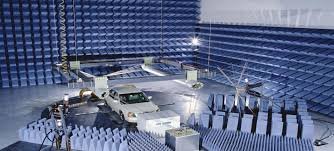EMC Testing for Electrical Components: Ensuring Compliance and Performance
EMC Testing for Electrical Components is essential for ensuring the reliability, safety, and compliance of electronic devices.

Introduction to EMC Testing for Electrical Components
EMC Testing for Electrical Components is a critical process that ensures electronic devices operate effectively without causing or suffering from electromagnetic interference (EMI). As electronic systems become increasingly complex, the need for EMC testing is more important than ever. This testing is essential for compliance with international standards, ensuring product reliability, and avoiding costly recalls.
What is EMC Testing?
EMC testing involves evaluating electronic components to determine their ability to function in an electromagnetic environment without causing interference or being affected by external electromagnetic waves. This testing is crucial for all industries, including automotive, aerospace, medical, and consumer electronics.
Importance of EMC Testing
-
Regulatory Compliance – Many countries require products to meet EMC standards before they can be sold in the market.
-
Product Reliability – Ensuring that components function correctly in real-world conditions.
-
Safety Assurance – Preventing interference that could lead to malfunctions in critical systems such as medical devices or aviation equipment.
-
Cost Savings – Identifying and addressing EMC issues early can reduce production costs and prevent expensive recalls.
-
Consumer Satisfaction – Reducing the risk of product failures enhances brand reputation and customer trust.
Key EMC Standards and Regulations
Different industries and regions have specific EMC regulations that products must comply with, including:
-
CISPR (International Special Committee on Radio Interference) – International standards for EMC testing.
-
FCC (Federal Communications Commission) – EMC regulations for electronic devices in the United States.
-
EN (European Norms) – European standards for electromagnetic compatibility.
-
ISO (International Organization for Standardization) – Standards for industrial and automotive components.
Types of EMC Testing
EMC testing is divided into two primary categories: Emission Testing and Immunity Testing.
1. Emission Testing
Emission testing evaluates how much electromagnetic interference a device generates. This ensures that the device does not disrupt other electronic equipment.
-
Radiated Emissions – Measures electromagnetic waves emitted into the air.
-
Conducted Emissions – Assesses electromagnetic noise transmitted through power lines and cables.
2. Immunity Testing
Immunity testing assesses a device’s ability to withstand external electromagnetic interference.
-
Electrostatic Discharge (ESD) Testing – Simulates static electricity discharges.
-
Radiated Immunity Testing – Ensures that a device can operate in environments with electromagnetic fields.
-
Conducted Immunity Testing – Tests the resilience of a device to electromagnetic interference in power and signal lines.
EMC Testing Process
The EMC testing process follows a structured approach to ensure thorough evaluation:
-
Pre-compliance Testing – Early-stage testing to identify potential EMC issues.
-
Formal Testing – Conducted in accredited laboratories to meet regulatory requirements.
-
Certification and Compliance – Upon successful testing, products receive certification marks such as CE, FCC, or UL.
Common EMC Testing Methods
-
Anechoic Chamber Testing – A controlled environment free from external interference for radiated emissions and immunity testing.
-
Reverberation Chamber Testing – Uses reflected waves to test high-field electromagnetic environments.
-
Open Area Test Site (OATS) – Conducts radiated emissions tests in an outdoor environment.
-
Shielded Room Testing – Prevents outside interference from affecting test results.
Challenges in EMC Testing
-
Design Complexity – Modern electronics have higher circuit density, increasing the risk of EMI issues.
-
Component Variability – Different suppliers may have slight variations in component design, affecting EMC performance.
-
Regulatory Updates – Evolving standards require continuous adaptation and testing.
-
Cost and Time Constraints – Comprehensive EMC testing can be expensive and time-consuming.
Best Practices for Ensuring EMC Compliance
-
Early EMC Considerations – Implement EMC-friendly design practices from the initial development phase.
-
Shielding and Grounding – Use proper shielding materials and grounding techniques to minimize interference.
-
PCB Design Optimization – Arrange circuit layouts to reduce unwanted electromagnetic emissions.
-
Proper Cable Management – Use twisted-pair wiring and ferrite beads to control electromagnetic noise.
-
Regular Testing and Validation – Conduct periodic EMC testing to ensure continued compliance.
Future Trends in EMC Testing
-
Automation in EMC Testing – Advanced testing equipment with automated analysis reduces human error and improves efficiency.
-
Wireless EMC Testing – As wireless technologies expand, EMC testing methodologies are evolving to ensure compliance.
-
Miniaturization Challenges – Smaller electronic devices require new EMC testing strategies due to increased circuit density.
-
Artificial Intelligence in EMC Analysis – AI-driven testing tools are improving diagnostic accuracy and speed.
Conclusion
EMC Testing for Electrical Components is essential for ensuring the reliability, safety, and compliance of electronic devices. As regulations become more stringent and technology advances, manufacturers must prioritize EMC testing to prevent interference issues and enhance product performance. Implementing best practices and staying updated with evolving standards will help companies achieve successful EMC compliance and maintain a competitive edge in the market.
What's Your Reaction?



















